Why? Because when companies look at incorrect data, they end up making incorrect decisions about customer experiences.
Inaccuracies in customer data creep in because a huge amount of this data is collected manually and in fragments over different touch points.
Download Free: A/B Testing Guide
Let’s say you want to target customers who purchased furniture for their homes in the last six months – and offer them a discount on their next purchase. In the absence of a centralized system, you will need to collect this data manually from various offline and online stores that sell your furniture, and at the very least, remove the duplication of customers. An activity as seemingly simple as this could take you weeks. Moreover, it is bound to be erroneous when you do it manually. You would also not be able to gather the most recent data through this exercise. And in the process, the piles of data end up being scattered, unattended, and eventually unused.
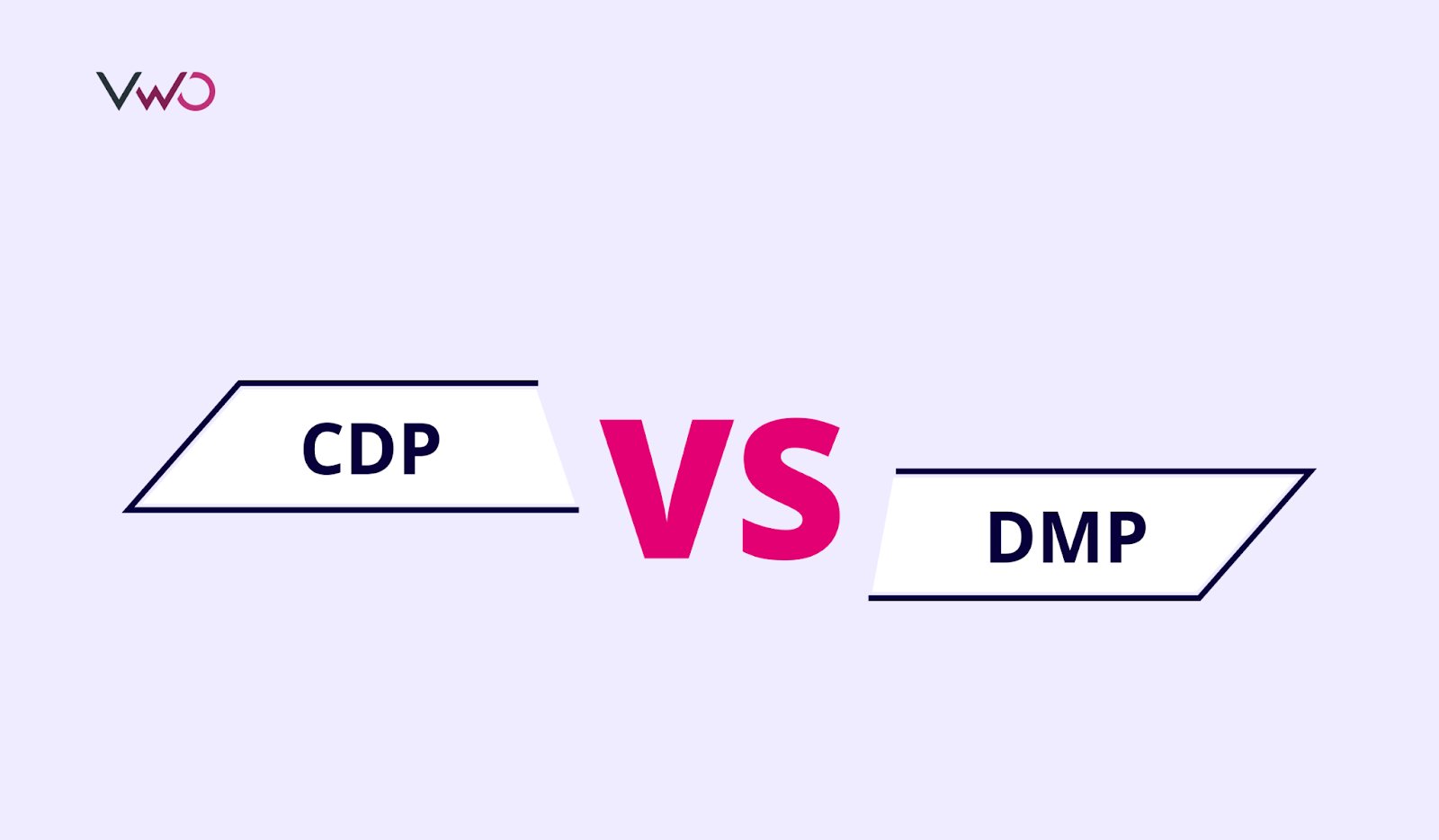
This is where you must go for either Customer Data Platforms or Data Management Platforms to overcome data challenges and strengthen your marketing strategy.
While both of these platforms can help you run successful marketing campaigns, the key lies in identifying your business requirements and then choosing a platform that meets your objectives.
Ask yourself questions like –
- What kind of data will help you accomplish your marketing goals?
- How are you going to use this data to target different customer identities?
- How long do you plan to store that data?
Answering these questions and identifying your marketing needs would be a good starting point in the exercise of choosing the right platform.
In this blog, you’ll understand the in and out of CDPs and DMPs, what they’re used for, and which one you should employ to create a better customer experience, target the right set of audiences, and convert them into paid customers.
What is a CDP?
A Customer Data Platform is used to collect, organize, and analyze data collected from different sources to create customer profiles.
A CDP takes the help of first-party, second-party, and third-party data to create customer profiles, organize data across millions of customer touchpoints, and determine customer needs and wants.
It makes the best use of all sources, like
- Analytics
- A/B testing
- Social media
- Marketing automation
- CRM
The best part?
CDP stores information from many sources and is built in a way that captures multiple data points, without losing the data or replicating it.
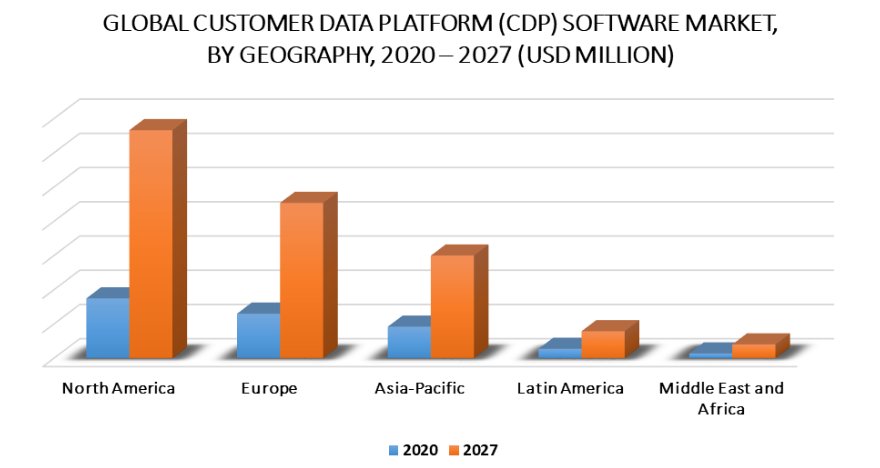
What data does a CDP track?
In order to create a detailed customer avatar, a CDP collects the following types of information based on the customer’s different touchpoints with the brand’s product.
Identification data
The data collected under this criterion aims to provide the basic demographics and information about the customer.
- Name
- Location
- Contact
- Demographics
- Social information
- Work information
- Personal information, if needed
Descriptional data
This data relates to the industry and the role of the customer. It takes into account the lifestyles and habits of the customer as well.
- Which industry are they working in?
- What’s the size of the company?
- The designation/role of the customer
- What’s the salary paid to them?
- Lifestyle habits like what kind of house they live in, etc.
- Habits, and hobbies of the customer
Behavioral data
Behavioral data outlines the customer’s action after knowing your brand, making the purchase, and everything that comes between the process of awareness and purchase.
- How many times have they abandoned a cart mid-purchase?
- How many times have they made a purchase?
- How many times was the same product bought twice?
- Did the customer accept an upsell offer promoted by the brand?
Furthermore, a CDP tracks data on email marketing providers to collect information about –
- Email open rates
- Email CTRs
- Amount of responses received, etc.
It also tracks website information, like –
- Website visits
- Click-throughs
- Product views
- Social media engagement.
Qualitative data
This data includes the customer’s motivation, actions/thoughts while buying, news on if they liked the product, and the service provided pre and post-purchase.
Benefits of using a CDP
Using a customer data platform benefits a brand in the following ways –
- It eliminates data silos and makes exporting data collected to any marketing and sales platform simple.
- It helps in maintaining the accuracy of data thereby reducing the chances of data discrepancies.
- It helps you in determining customer intent with the help of an up-to-date customer view.
- It ensures that you’re following the latest data compliance rules.
- It creates better and unified customer profiles.
- It helps you extract data from different customer journeys so you can create personalized messages to meet them at every stage of their interaction with you.
- It helps you in integrating fragmented data.
Now that you know what a CDP is and the benefits it provides, it’s time to understand what a DMP is, and how it helps your marketing purposes.
What is a DMP?
A Data Management Platform collects and organizes data of audiences from various sources(mostly third-party, and a bit of second-party data) to create anonymized customer profiles. Marketers use this data to create better and highly personalized ad campaigns.
Difference between CDP and DMP
| Customer Data Platform | Data Management Platform |
| CDPs depend on PII(Personally Identifiable Information) to collect as much customer data as possible from all the customer touchpoints. | DMPs don’t use PII as they collect data on anonymous users. |
| CDPs mostly collect first-party data along with a bit of second-party data. This second-party data is usually a result of data sharing between the two tools. | DMPs collect data from third-party platforms with some second-party data that comes from data exchange. |
| CDPs allow data to be stored for a longer time, or a set duration. These platforms allow the users’ customers to delete the data as and when they want. | DMPs don’t allow data storage for a longer time. As most customers’ interests and preferences change, thus retaining years-old data doesn’t help. |
Despite having all these differences, both CDPs and DMPs have their advantages. To decide between one of these platforms, you need to take a look at how they work.
CDP vs DMP (How do these platforms work)
How does CDP work?
A CDP collects data from websites, email marketing CRMs, transactional and eCommerce data, along with certain API integrations.
Once the data is collected from the sources, CDPs normalize and enrich the data to create a Single Customer View(SCV). This SCV helps the platforms in creating analytical reports, activate the audience, and create different customer avatars and segments.
The most important function of a CDP is to activate the audience on the company’s website, CRM, social media profiles, and search advertising.
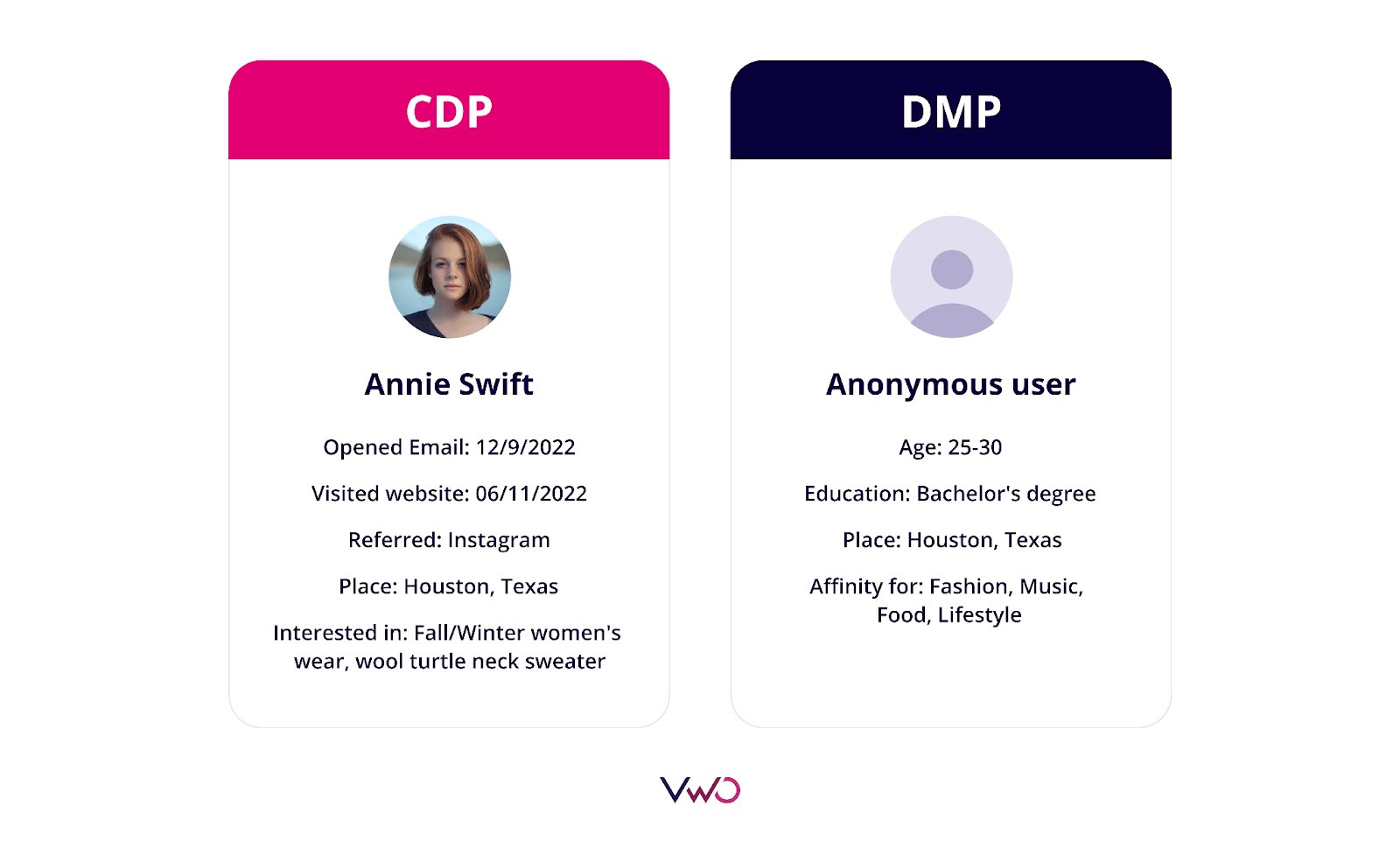
Say, for instance, an eCommerce brand wants to increase its sales of carpet rugs. To achieve this, they decide to cross-sell carpet rugs to those who have purchased coffee tables or beds in the past from their online store. In this case, a CDP can help with data like age, gender, average browsing time, location, etc. of these customers. It can also provide click-through rates, email open rates, and other important information to improve the targeting of this segment of customers.
Using this data, the eCommerce brand can create personalized messages recommending carpet rugs, offer discounts and one-time offers, and send targeted emails, SMS, etc, increasing the likelihood of customers making the desired purchase. The data collected from the CDP can be used to optimize experiments, and personalize the buying journey of the customer leading to an increase in sales and revenue.
Download Free: A/B Testing Guide
How does DMP work?
DMPs collect data from various sources(mostly third-party), like websites and emails. These platforms also make use of data brokers and other corporate partners.
The collected data is then normalized. During data normalization, visitor IDs are gathered from cookies, useless data is removed, and other data attributes like geolocation and OS/browser are added. This helps in organizing the data into structured formats and improving data quality.
Once the data is organized, DMPs use it to build a customer profile. As most of the data in DMPs is anonymized, profile building helps in creating different audience segments and eliminating duplicate profiles.

The customer profiles are shared with the ad teams or agencies so that they can perform advertising activities with accurate customer data and profiles. Once the ads start running, DMPs collect the performance metrics and use them to improve future ad creation and purchases.
What kind of data is stored by DMP & CDP?
The customer data both DMPs and CDPs collect widely differs from each other.
CDPs collect first-party customer data from multiple sources to create one single view of each customer. Marketers use this data to create more targeted and customized marketing strategies—CDPs help in unifying all the data collected to a Single Customer View or SCV.
DMPs use browser identifiers like website cookies, Apple IDFA or Android AAID for Mobile, and Samsung TIFA for TV devices to gather data. Each identifier used in the process of collecting and compiling the data results in an individual view of each audience.
Why should one use a CDP over a DMP?
There are certain functions that a DMP can’t perform, which gives a CDP advantage over a DMP.
Here are 6 reasons why you should use CDPs over DMPs.
- CDP collects first-party data from various sources, even A/B tests, to create long-term customer engagement.
- CDPs can help you create customer-centric and personalized marketing messages and campaigns based on accurate data.
- They help obtain personally identifiable information.
- CDPs collect first-party data ethically and show proper data collection protocols have been followed.
- CDPs track customer data on websites that different marketing tools can use if needed. They also help in categorizing website visitors into different customer segments.
- You can use the data collected by a CDP for different purposes, like A/B testing, personalization, and ABM strategy, among many others.
DMP vs CDP use case
Samantha, a marketing head at an eCommerce business, wants to create hyper-personalized marketing messages across the company’s website to drive more sales on its newly-launched recyclable coffee cups. She uses VWO Data360 to collect customer data and personalize marketing campaigns.
VWO Data360 facilitated easy tracking and unification of customer data from different touch points across multiple channels – from the browser sources like traffic and device to third-party sources like CMS, CRM, and offline POS channels. By synthesizing all that data to create a single view of customer profiles, the platform allowed Samantha to craft tailored messages based on it.
Customer segments (drawn on the collected data) that showed an affinity for or interest in coffee accessories or related items were shown personalized banners, product recommendations, and coupon offers on the website.
It is this creation of contextual experiences for the right audience at the right time that can help you, just like Samantha, increase sales and earn customers’ confidence.
This doesn’t end here; with VWO Data360’s metric module, you can create rule-based metrics to track complex metrics like average order value and lifetime value per customer.
So, can Samantha track crucial metrics to analyze customers’ reactions to her personalized campaigns on recyclable coffee cups? Of course!
Now, if Samantha’s marketing goal was only to run display advertisements, a DMP would have worked just fine. Collecting data for a shorter duration, a DMP supports running short-term targeted campaigns instead of helping with customer engagement improvement in the long run.
The best part about using a CDP like VWO Data360? Samantha can also use first-party data collected by the CDP in ad targeting on other platforms. VWO Data360 allows you to integrate customer data with any third-party platforms like your CRM, engagement platform, sales support platform, and so on, for both granular analysis and crafting targeted ads on those platforms.
Final thoughts
CDPs and DMPs have respective roles to play in making marketing campaigns successful for a business. But as we pointed out early on, CDPs do enjoy some benefits over DMPs for several reasons. Most importantly, in a fast-approaching cookieless world, strengthening your reliance on 1st party data-driven CDPs becomes a priority if you want to continue winning at marketing.
]]>What does a ‘jigsaw puzzle’ stand for, in your digital context?
The ability for you to look at outcomes for a visitor (or user) instead of focusing on their individual sessions. Positive outcomes (form fills, feature adoption, add-to-baskets, purchases, etc.) are the inspiration for you to replicate similar experiences for fence-sitters and non-committals to add to your happy outcome ticker. Negative outcomes (funnel leaks, form drops, cart abandonment, diminishing feature usage, etc.) are opportunities to identify friction points and quash them in your next sprint.
Download Free: A/B Testing Guide
What are its ‘individual components’?
TL:DR: Individual, unique, disparate sessions are individual components of the puzzle.
No positive outcome is an isolated event. Pure Experience Optimization is a function of looking at the bigger picture: individual sessions provide little merit. In a Wolfgang report, we learned that 81% of visitors who converted engaged in at least 5 sessions before whipping out their credit cards. We envisage that the ratio of sessions: conversion will only increase in the future, owing to the proliferation of new research channels (open-social, dark-social & niche aggregators)
Trying to optimize experiences by relying on individual sessions is an exercise in futility: you stand to lose more than the gains. Loss of context by focusing on individual sessions to elevate user experience is a derailer & we want to address it by unifying data across sessions at a visitor level.
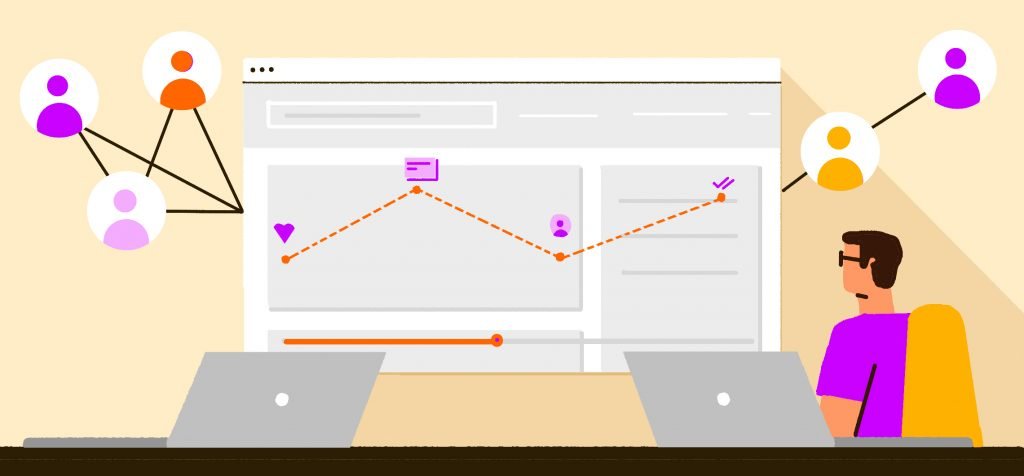
The ‘Collective’ – Announcing Visitor Profiles
A little over a month ago, in one of our recurring customer calls, our product team bumped into an interesting use case
“We run continuous surveys to identify optimization opportunities. NPS surveys are our go-to instrument to accomplish this. Approximately, 10% of our users rate us 10/10. We want to filter all experiences from their first visit to their last, identify delight points and try to replicate similar experiences for other visitors falling in the same segment”
The customer wanted to empathize with their Promoters. Instead of looking at disjointed sessions of Promoters, they wanted to attach a User ID for all unique sessions and unify session logs for them to analyze ‘aha’ moments for each Promoter individually. The hypothesis was simple – replicating these ‘aha’ moments for Passives and Detractors would turn them into Promoters.
Which leads us to Visitor Profiles.
Starting today, all our Pro, Growth & Enterprise customers will have access to Visitor Profiles under Session Recordings in our Insights product. Multiple sessions across all Returning Visitors will be classified under a larger ‘Visitor’ umbrella for you to replay connected experiences.
Not just that, we have also introduced an additional capability to bolster user-level analysis of friction in their respective experiences – all recordings will be replete with specific instances of Rage and Dead clicks across individual sessions for the entire journey. For even richer analysis, we recommend using Custom Dimensions that can be used to dig out the deeper gaps in a customer’s experience. –
For example, teams can analyze “logged in” and “logged out” visitor behavior and engagement metrics. A visitor-level customer identifier is fired to VWO which classifies visitors in 3 buckets – visitors yet to sign-up, visitors who have signed up but are inactive and logged-in users. With this information, teams can exclude inactive and logged-in users from their sign-up campaigns for wholesome experiences for everybody.
We envision our customers exploiting Visitor Profiles and their Recordings for the following jobs (indicative list)
Higher experimentation velocity:
- Generating quality hypothesis for continuous experimentation is one of the trickier challenges for growth teams. With Visitor Profiles and their associated frustration hotspots, Experience Managers can discover friction areas quickly and work towards experimenting with refined variations in their next release. Higher experimentation velocity is a natural outcome of observing Visitor Profiles.
Intervening in the moment of displeasure:
- A higher than usual occurrence of rage and dead clicks by a visitor is a proxy for ‘displeasure’. Experience Managers can build an intelligent system that triggers an intervention when a visitor taps a cut-off number of rage & dead clicks. As an example, a Fortune 50 Digital Innovation team tested triggering a chatbot for visitors showing signs of displeasure and secured an NPS of 8.5 against their average site NPS of 6.8
Arming Customer Support teams with rich customer context for their next conversation:
- With a visitor level view of customers, Support teams can replay videos and filter them by specific instances of displeasure along with coupling them with specific app. elements that caused friction. For example, Customer Success teams can check out Visitor Recording for sessions which concluded with a Support Ticket. Reach out to us if you wish to initiate this for your Support teams
Download Free: A/B Testing Guide
Getting Started With Visitor Profiles
If you are on a Pro, Growth or Enterprise plan, you can now access Visitor Profiles under Session Recordings. You can find them as a distinct tile to the right of session logs in the bottom panel of the Recordings capability.

More important than checking out Visitor Profiles is understanding the philosophy (or approach) behind the successful adoption of Profiles.
Often, optimization teams would want to grab a holistic view of positive/negative sessions. Negative sessions, however, serve as a constant stream of learning. For example, eCommerce teams might want to observe funnel drops closely. However, the current model of approaching funnel drops by session is limiting, in nature. Drop-offs in the current session might not be independent of the session alone: there might have been negative experiences in the past few sessions that might have led to the negative outcome. By looking at Visitor Profiles in unison, teams can be more certain in their user understanding and can influence curation of quality hypothesis.
Following are some cues that might help you refine your analysis heuristics.
- Customers can analyze data by Custom Dimensions of their choice: In the sidebar, you will find Custom Profiles under ‘Visitor Profile’. We envision our customers analyzing recordings across segments of choice – eCommerce customers can analyze experiences for product category usage, repeat buyers, gender, country, etc.- the only limit is your imagination. Similarly, SaaS customers can segment by plans, feature usage, high NPS & plan upgrades to name a few.
You can find the Custom Dimension under the scanner, in the right sidebar overlay on top of the recording
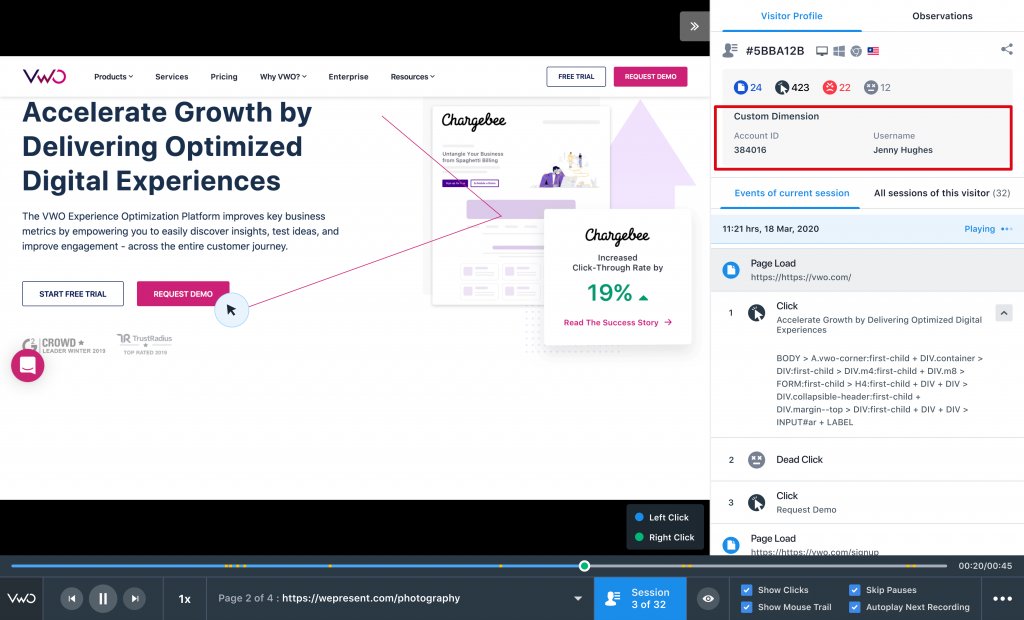
- Analyzing by specific instances of user displeasure: For customer-centric teams seeking granularity in their analysis, Visitor Profiles store and display specific instances of displeasure across a particular session or the entire journey. By clicking on any instance, you will access additional information behind the specifics of displeasure – page element, displeasure type (rage, dead or idle click) and the exact moment in their journey behind the displeasure.
Just hover & click on the instance under Events. This data is available for both unique sessions as well as the entire journey
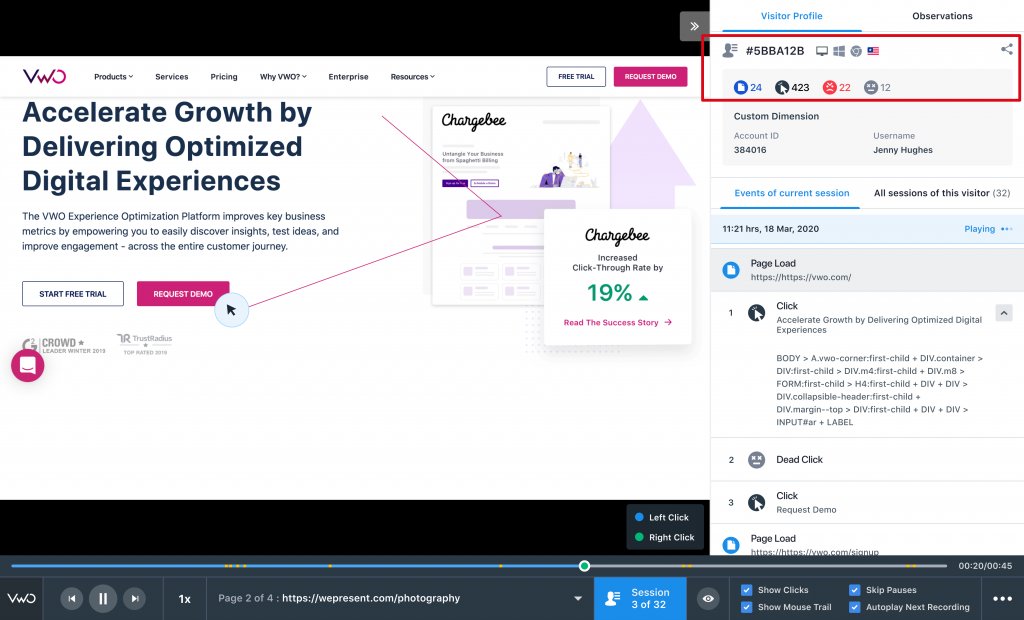
- Collaborative Analysis: High-performance Optimization teams are a cross-functional set of professionals with vested interests spanning across Product, Marketing, UX, Analytics, BA and Customer Support teams. Users might want to share interesting Profiles with members falling outside the core CRO team.
Following are certain use-cases that we envisage
- For sales teams: Sales teams love to be powered with rich context behind every lead that signs up. Through Visitor Profiles, they can have an in-depth look at the lead journey from start to finish.
- For success teams: Success teams can have a look at user onboarding videos and segregate various stages. The insights gleaned during the journey from prospect to customer can provide a rich context for them before they interact with the customer.
You can find share elements for all Profiles beside the Visitor descriptor
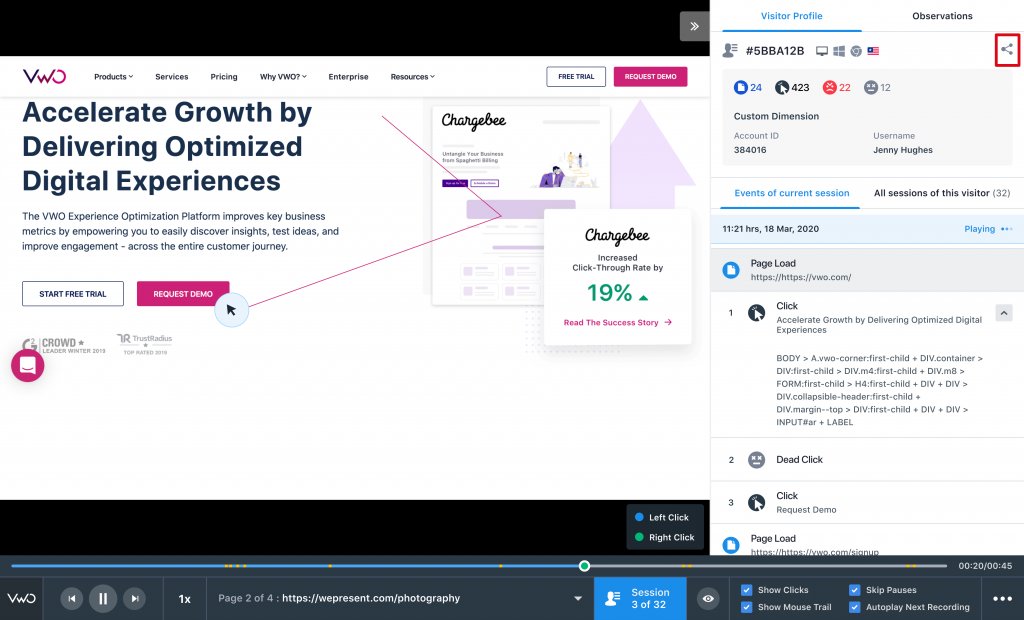
We thrive on user feedback as a compass for feature upgrades and new roll-outs. Drop us a line at [email protected] with your feedback for Visitor Profiles. We look forward to your usage stories.
Online businesses have access to a tonne of customer data, thanks to the plethora of analytics tools available. (It is not just Google Analytics that does the trick)
Unfortunately, data reveals only the symptoms and tells nothing about the subjective experiences of a user. This is where mapping out the customer journey can be of immense help in understanding the customer better and providing value where they require it.
Download Free: Customer Engagement Guide
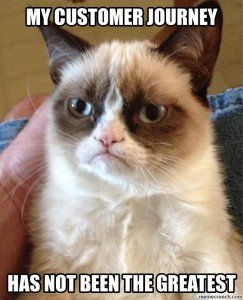
Customer journey is quite simply a storyboard that shows how customers engage with different media, consume information, and make decisions while moving through the different stages of a buying process – awareness to engagement to purchase. Check out this delightfully detailed article on customer journey mapping.
There are various reasons why customer journeys can add a tremendous amount of value to a service. I like to apply a customer journey to activities that fall within the online channel: SEA, SEO, and conversion rate optimization. We created a customer journey for EUclaim in order to establish contact with the customer at the right online moments and also to ease the customer’s experience on the website, both of each ultimately leads to more sales.
EUclaim, established in 2007, is a European market leader when it comes to offering support to long-delayed passengers in terms of their rights. They do this through a combination of investigating delays, submitting claims, and where required, proving in a court of law that a claim is legitimate. As a result of this support, the passenger is then able to successfully claim their right to compensation.
Flight Delays and EUclaim
Delays are all too common in air travel. According to EU regulation 261/2004 passengers are, subject to certain conditions, eligible for financial compensation in case of flight delay. Such compensation applies when passengers arrive too late at their destination due to a delay, denial of boarding, cancellation of flight, or when they miss their connecting flight. Depending on the distance, the compensation that passengers are eligible for is as high as 600 Euros per passenger. Of course, compensation is not applicable to all delays.
The conditions for a legitimate claim are:
- Arriving at one’s destination at least three hours later than planned (two hours in case of cancelled flights)
- No exceptional circumstances (for example weather conditions or strikes)
- Not having been informed about the delay or cancellation at least two weeks in advance
- Not having received an offer to take a different flight in order to ensure on-time arrival at one’s destination.
Experience shows that legitimate claims by delayed passengers are often rejected, with airline companies resorting to “force majeure” in order to avoid settling a claim.
The business model of EUclaim works on the basis of a commission that is paid to the company every time a passenger claim is actually paid out. And they strictly adhere to the “no cure, no pay” model. When a lawsuit against an airline company is not won, the consumer will not bear any of the costs associated with the lawsuit.
The service provided by EUclaim takes place predominantly online. A customer journey has been set up to map the journey taken by the customer and consequently to identify and address as many potential improvements as possible.
Customer Profile
Before the customer journey can be mapped, a profile of the customer (at least in summary form) is needed. Despite there being a number of customer profiles, each with their own unique customer journey, most of the customers who connect with EUclaim fit the following profile:
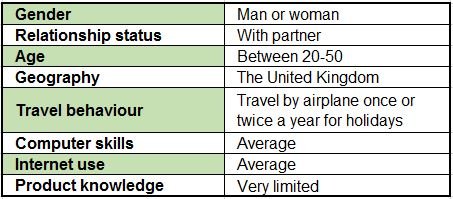
The Customer Journey
The complete customer journey as we researched is quite long and can be found here. For the sake of brevity, I’ll only be touching upon the most important points from the customer journey in this article.
The Journey
Going on holidays is an occasion everyone looks forward to. Before the trip there may be some stress from time to time, but all in all there is excitement because people are going to do something enjoyable (presumably) and they are about to create fantastic memories. However, the traveler has very limited control over the situation should anything go wrong with the flight.
A customer journey is generally a positive experience, until the return flight is confirmed and there seems to be a delay. The behavior is then as follows:

One major problem that passengers have to contend with is a lack of transparency. When a delay occurs, there is often a lack of communication about how long the delay is going to be. There are actually examples of an airplane not yet standing on the right airport, but still the passengers are kept in the dark. It is not clear whether this is caused by wanting to avoid embarrassment, or whether the employee at the counter who is being asked simply does not know. What is clear is that this type of behavior does not help the passenger one bit. The mood of the passenger starts to deteriorate.
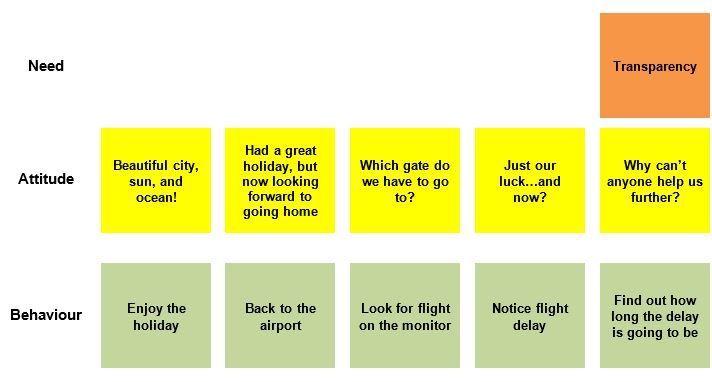
Travelers feel powerless, uninformed, and are in urgent need of clarity. This is, along with loss of luggage, one of the least pleasant ways to conclude a holiday. Passengers have no option but to wait and keep an eye on the screens. And before you know, they are wandering aimlessly around the terminal. They have already exhausted the shopping options in the airport and now all that is left for them is to just browse the internet.
Very soon posts start appearing on social media, with passengers making clear their dissatisfaction and frustration with regards to the delay, as well as the lack of clarity about it from the airline.
Rights of Passengers
The next phase is characterized by long periods of waiting and looking for answers on the internet. Customers want to know what their rights are. The disadvantage to EUclaim when it comes to the provision of this service is that many, many travelers are not familiar at all with the relatively new legislation in this area. As a result a common search term is then simply “flight delayed”.
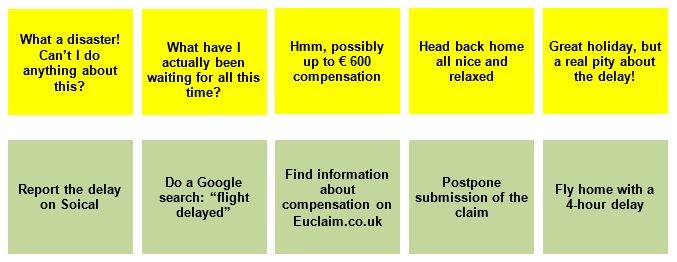
Customers are often unaware that they can claim food, drinks and overnight accommodation. In the case of long delays, they can also claim damage compensation. EUclaim provides this information on its website and offers further support to delayed travelers. It is very important for EUclaim to be visible to travelers already when they are just starting to look for information online. This first possible point of contact with a potential future customer is not to be taken lightly!
In order to be visible at the time of the internet search, SEO must be taken very seriously, but Google AdWords is also used.
Download Free: Customer Engagement Guide
Claim Submission
Upon arrival at home, the customer goes back to life as usual, but still keeps in mind the potential financial compensation. There will therefore be a new search for “flight delayed” or, as in many cases, “euclaim”.
It also often occurs that passengers submit a claim with the airline company themselves. EUclaim also regularly advises delayed travelers to first try submitting a claim themselves. Unfortunately, in very many cases, the complaints of travelers are rejected using a “force majeure” argument, even when this was not the case. It is at that moment that travelers come back to EUclaim.
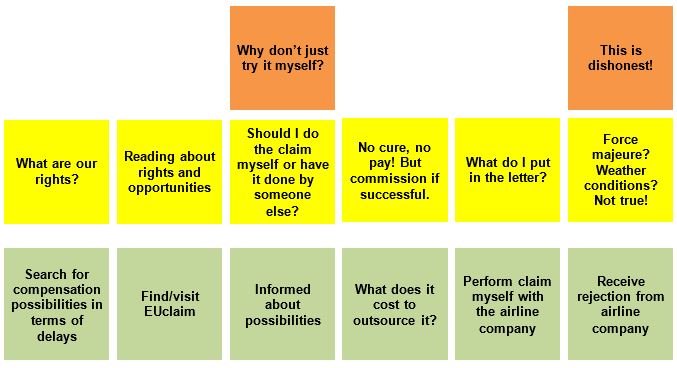
The repeat visit to EUclaim.co.uk once again takes place through Google, even though they then often remember the name. It is therefore again important to be thoroughly visible on Google.co.uk.
When the delayed traveler returns to the EUclaim.co.uk website, their intention is different to what it was before. This visitor now intends to hand the claim over to EUclaim. This is where the wizard becomes crucial for the purpose of winning the trust of the visitor. Reviews are an important means by which to achieve this. Before, EUclaim would collect and post reviews on the site. With regards to the visibility in search engines via rich snippets and in order to prove objectivity, it has now decided to use Trustpilot for this. Customers seem to appreciate the results and functionality of Trustpilot.
The wizard is therefore very important. This is where they get advice regarding the fairness of a claim and get EUclaim officially involved. In other words, this is where a mere visitor can turn into a customer. The wizard comprises four steps:
- The flight information
- The problem (delay, missing of connecting flight, flight cancellation or denial to board)
- The value of the damage compensation that the customer has a right to claim
- The submission of the claim at EUclaim
By referring to the flight number, the date, the type of delay and EUclaim’s own information about flights and external factors, EUclaim now determines whether or not the claim is valid. During this process there are often questions that visitors want to ask EUclaim. A/B tests have shown that visitors like to make use of the chat option to get in touch with EUclaim staff. Visitors prefer this option because of the lack of clarity about complex trips, such as those involving connecting flights.
Tests have also been conducted regarding the order of steps in the wizard. While contact details are obviously needed in order to process a claim, originally an e-mail address was requested before displaying the claim advice and the amount. Now this information is displayed first, and only then are the contact details requested. Visitors appreciate this method, as it ensures more concrete advice and better conversion.
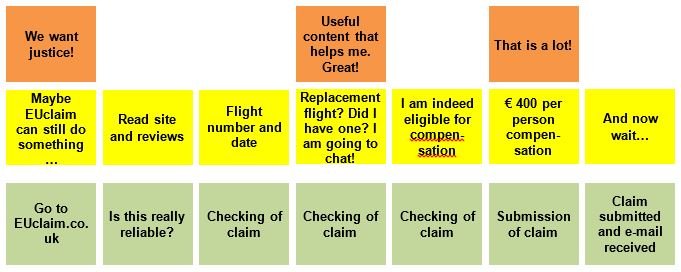
Since the wizard is such an essential part of the customer experience, it is continuously tested to improve usability. This leads to even better visitor numbers as well as a decrease in the number of visitor queries about using the wizard.
The rest of the customer journey consists of being kept up-to-date with regard to the progress, and the determination of the settlement amount, followed by the actual settlement and a request to write a short review about the experience with EUclaim. A very high number of customers then write a positive review about both the service they received as well as the results that were achieved.
The Customer Journey and The Online Improvements
The customer journey that has been set up has had a major influence on the EUclaim website as well as the A/B tests.
The EUclaim website was revamped at the beginning of the year. It needed a more modern and fresh look, but the real aim was to increase customer satisfaction. That is why a number of things were simultaneously changed at the time. These included a better implementation of the Trustpilot reviews.
Setting up a good landing page was also especially important. When people land on the flight delayed page, there are two key questions that have to be answered:
- What are the rights of delayed passengers?
- Does compensation apply to my case?
Such matters were addressed in the new design and also further optimized at a later stage through A/B testing.
A/B testing is an important method for improving usability, with further improvements being dependent on an extensive test plan with hypotheses. Chat was for instance one option to increase customer satisfaction. An A/B test on customer behavior with and without chat provided us with an answer about whether or not we should implement it: visitors appreciate chat as a channel and are therefore more likely to submit a claim. It offers real time clarification to those nagging last-minute queries and help ease customer anxieties. With a live chat option, the customer is unlikely to bounce off looking for answers elsewhere.
Other tests look at the need for information and what aspects regarding the compensation need to be explained.
Visibility is a key factor when trying to attract visitors to EUclaim. This is extremely important especially in Google search. Attention is therefore paid to PR (offine), SEO and AdWords. An important point in empowering customers then is to provide visible and actionable direction for travelers. In order to achieve this, EUclaim also publishes press releases about the most delayed flights and blogs (on their own website) about relevant legislation and the circumstances that are eligible to win a compensation.
Why This Customer Journey
A detailed customer journey reveals many interesting areas for improvement. The question is whether or not the above improvements could also have been identified without a customer journey. The answer is, yes, it is possible. Many roads lead to Rome.
I do find a customer journey an enjoyable way of working, because it provides so much insight into the perspective of the customer, the processes customers undertake, and the emotions they evoke. It provides very meaningful information in a structured manner. In the online realm the customer journey involves advertising, UBRs (unique buying reasons) that are relevant at that exact moment, information written on the website, contact information and programming on the website (the wizard).
Therefore, even when a customer journey is only being applied to the online channel, it provides an enormous amount of benefits. I think the investment of time necessary to conduct one is definitely worth it.
For those who have not yet created a customer journey or are looking for more information about the basics of it, this is a good hands-on presentation about customer experience and setting up a customer journey.
So, have you set up a customer journey yet? If not, has this post pushed you an inch closer to doing it? If you don’t agree with us on this, please write to us at [email protected]!
As always, we are listening.
]]>